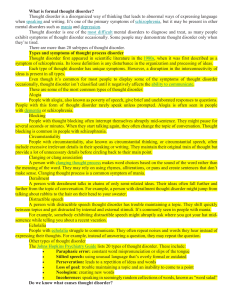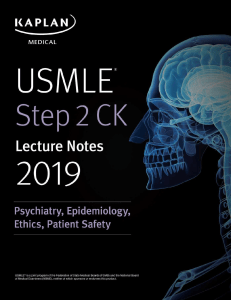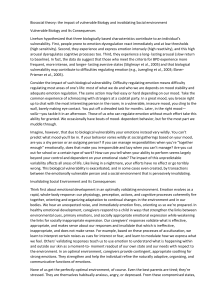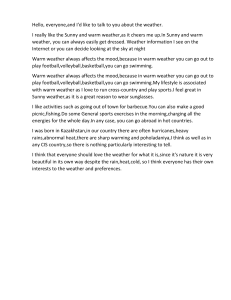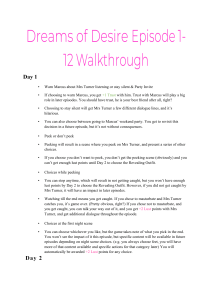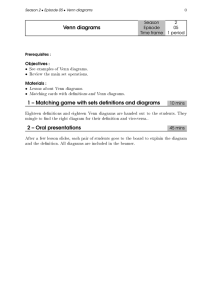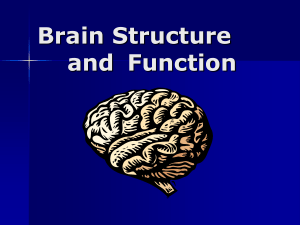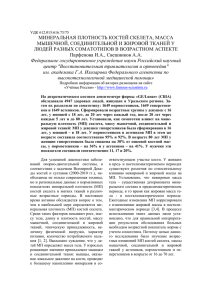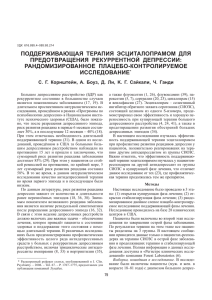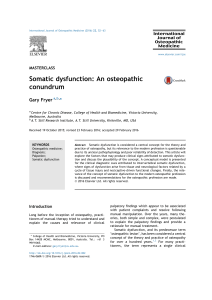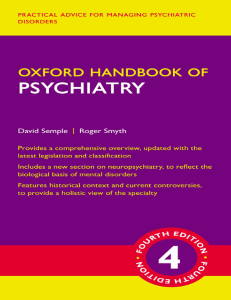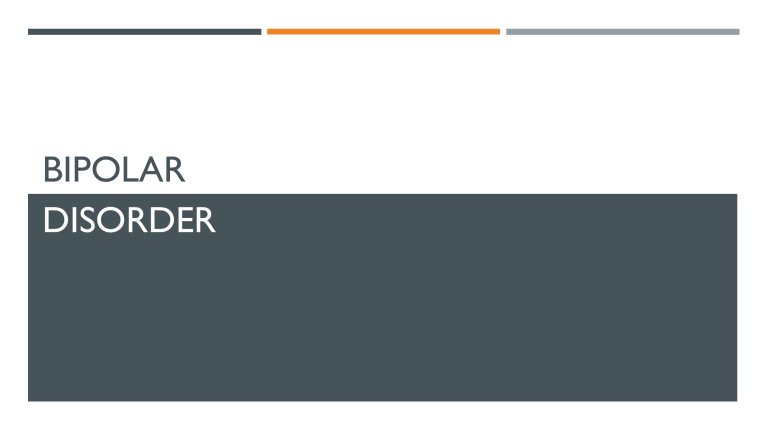
BIPOLAR DISORDER MANIC EPISODE At least one lifetime manic episode is required for the diagnosis of bipolar I disorder. I. A distinct period of abnormally and persistently elevated, expansive, or irritable mood and abnormally and persistently increased goal-directed activity or energy, lasting at least 1 week and present most of the day, nearly every day (or any duration if hospitalization is necessary). II. During the period of mood disturbance and increased energy or activity, three (or more) of the following symptoms (four if the mood is only irritable) are present to a significant degree and represent a noticeable change from usual behavior: 1. Inflated self-esteem or grandiosity. 2. Decreased need for sleep (e.g., feels rested after only 3 hours of sleep). 3. More talkative than usual or pressure to keep talking. 4. Flight of ideas or subjective experience that thoughts are racing. 5. Distractibility (i.e., attention too easily drawn to unimportant or irrelevant external stimuli), as reported or observed. 6. Increase in goal-directed activity (either socially, at work or school, or sexually) or psychomotor agitation (i.e., purposeless non-goal-directed activity). 7. Excessive involvement in activities that have a high potential for painful consequences (e.g., engaging in unrestrained buying sprees, sexual indiscretions, or foolish business investments). III. The mood disturbance is sufficiently severe to cause marked impairment in social or occupational functioning or to necessitate hospitalization to prevent harm to self or others, or there are psychotic features. IV. The episode is not attributable to the physiological effects of a substance (e.g., a drug of abuse, a medication, other treatment) or to another medical condition. HYPOMANIC EPISODE Hypomanic episodes are common in bipolar I disorder but are not required for the diagnosis of bipolar I disorder. I. A distinct period of abnormally and persistently elevated, expansive, or irritable mood and abnormally and persistently increased activity or energy, lasting at least 4 consecutive days and present most of the day, nearly every day. II. During the period of mood disturbance and increased energy and activity, three (or more) of the following symptoms (four if the mood is only irritable) have persisted, represent a noticeable change from usual behavior, and have been present to a significant degree: 1. Inflated self-esteem or grandiosity. 2. Decreased need for sleep (e.g., feels rested after only 3 hours of sleep). 3. More talkative than usual or pressure to keep talking. 4. Flight of ideas or subjective experience that thoughts are racing. 5. Distractibility (i.e., attention too easily drawn to unimportant or irrelevant external stimuli), as reported or observed. 6. Increase in goal-directed activity (either socially, at work or school, or sexually) or psychomotor agitation. 7. Excessive involvement in activities that have a high potential for painful consequences (e.g., engaging in unrestrained buying sprees, sexual indiscretions, or foolish business investments). III. The episode is associated with an unequivocal change in functioning that is uncharacteristic of the individual when not symptomatic. IV. The disturbance in mood and the change in functioning are observable by others. V. The episode is not severe enough to cause marked impairment in social or occupational functioning or to necessitate hospitalization. If there are psychotic features, the episode is, by definition, manic. VI. The episode is not attributable to the physiological effects of a substance (e.g., a drug of abuse, a medication, other treatment). MAJOR DEPRESSIVE EPISODE Major depressive episodes are common in bipolar I disorder but are not required for the diagnosis of bipolar I disorder. I. Five (or more) of the following symptoms have been present during the same 2-week period and represent a change from previous functioning; at least one of the symptoms is either (1) depressed mood or (2) loss of interest or pleasure. 1. Depressed mood most of the day, nearly every day. 2. Markedly diminished interest or pleasure in all, or almost all, activities most of the day, nearly every day. 3. Significant weight loss when not dieting or weight gain (e.g., a change of more than 5% of body weight in a month), or decrease or increase in appetite nearly every day. 4. Insomnia or hypersomnia nearly every day. 5. Psychomotor agitation or retardation nearly every day. 6. Fatigue or loss of energy nearly every day. 7. Feelings of worthlessness or excessive or inappropriate guilt (which may be delusional) nearly every day (not merely self-reproach or guilt about being sick). 8. Diminished ability to think or concentrate, or indecisiveness, nearly every day. 9. Recurrent thoughts of death (not just fear of dying), recurrent suicidal ideation without a specific plan, or a suicide attempt or a specific plan for committing suicide. II. The symptoms cause clinically significant distress or impairment in social, occupational, or other important areas of functioning. III. The episode is not attributable to the physiological effects of a substance or another medical condition. RISK AND PROGNOSTIC FACTORS Environmental Bipolar disorder is more common in high-income than in low-income countries (1.4 vs. 0.7%). Separated, divorced, or widowed individuals have higher rates of bipolar I disorder than do individuals who are married or have never been married, but the direction of the association is unclear. Genetic and physiological A family history of bipolar disorder is one of the strongest and most consistent risk factors for bipolar disorders. There is an average 10-fold increased risk among adult relatives of individuals with bipolar I and bipolar II disorders. Magnitude of risk increases with degree of kinship. Schizophrenia and bipolar disorder likely share a genetic origin, reflected in familial co-aggregation of schizophrenia and bipolar disorder. Course modifiers After an individual has a manic episode with psychotic features, subsequent manic episodes are more likely to include psychotic features. Incomplete inter-episode recovery is more common when the current episode is accompanied by mood-incongruent psychotic features. SOMATIC SYMPTOM DISORDER DIAGNOSTIC CRITERIA I. One or more somatic symptoms that are distressing or result in significant disruption of daily life. II. Excessive thoughts, feelings, or behaviors related to the somatic symptoms or associated health concerns as manifested by at least one of the following: 1. Disproportionate and persistent thoughts about the seriousness of one’s symptoms. 2. Persistently high level of anxiety about health or symptoms. 3. Excessive time and energy devoted to these symptoms or health concerns. III. Although any one somatic symptom may not be continuously present, the state of being symptomatic is persistent (typically more than 6 months). Severity: Mild: Only one of the symptoms specified in Criterion II is fulfilled. Moderate: Two or more of the symptoms specified in Criterion II are fulfilled. Severe: Two or more of the symptoms specified in Criterion II are fulfilled, plus there are multiple somatic complaints (or one very severe somatic symptom). RISK AND PROGNOSTIC FACTORS Temperamental The personality trait of negative affectivity (neuroticism) has been identified as an independent correlate/risk factor of a high number of somatic symptoms. Comorbid anxiety or depression is common and may exacerbate symptoms and impairment. Environmental Somatic symptom disorder is more frequent in individuals with few years of education and low socioeconomic status, and in those who have recently experienced stressful life events. Course modifiers Persistent somatic symptoms are associated with demographic features (female sex, older age, fewer years of education, lower socioeconomic status, unemployment), a reported history of sexual abuse or other childhood adversity, concurrent chronic physical illness or psychiatric disorder (depression, anxiety, persistent depressive disorder, panic), social stress, and reinforcing social factors such as illness benefits. PSYCHOLOGICAL FACTORS AFFECTING OTHER MEDICAL CONDITIONS I. A medical symptom or condition (other than a mental disorder) is present. II. Psychological or behavioral factors adversely affect the medical condition in one of the following ways: 1. The factors have influenced the course of the medical condition. 2. The factors interfere with the treatment of the medical condition (e.g., poor adherence). 3. The factors constitute additional well-established health risks for the individual. 4. The factors influence the underlying pathophysiology, precipitating or exacerbating symptoms or necessitating medical attention. III. The psychological and behavioral factors in Criterion II are not better explained by another mental disorder (e.g., panic disorder, major depressive disorder, posttraumatic stress disorder). IV. Specify current severity: Mild: Increases medical risk (e.g., inconsistent adherence with antihypertension treatment). Moderate: Aggravates underlying medical condition (e.g., anxiety aggravating asthma). Severe: Results in medical hospitalization or emergency room visit. Extreme: Results in severe, life-threatening risk (e.g., ignoring heart attack symptoms).
